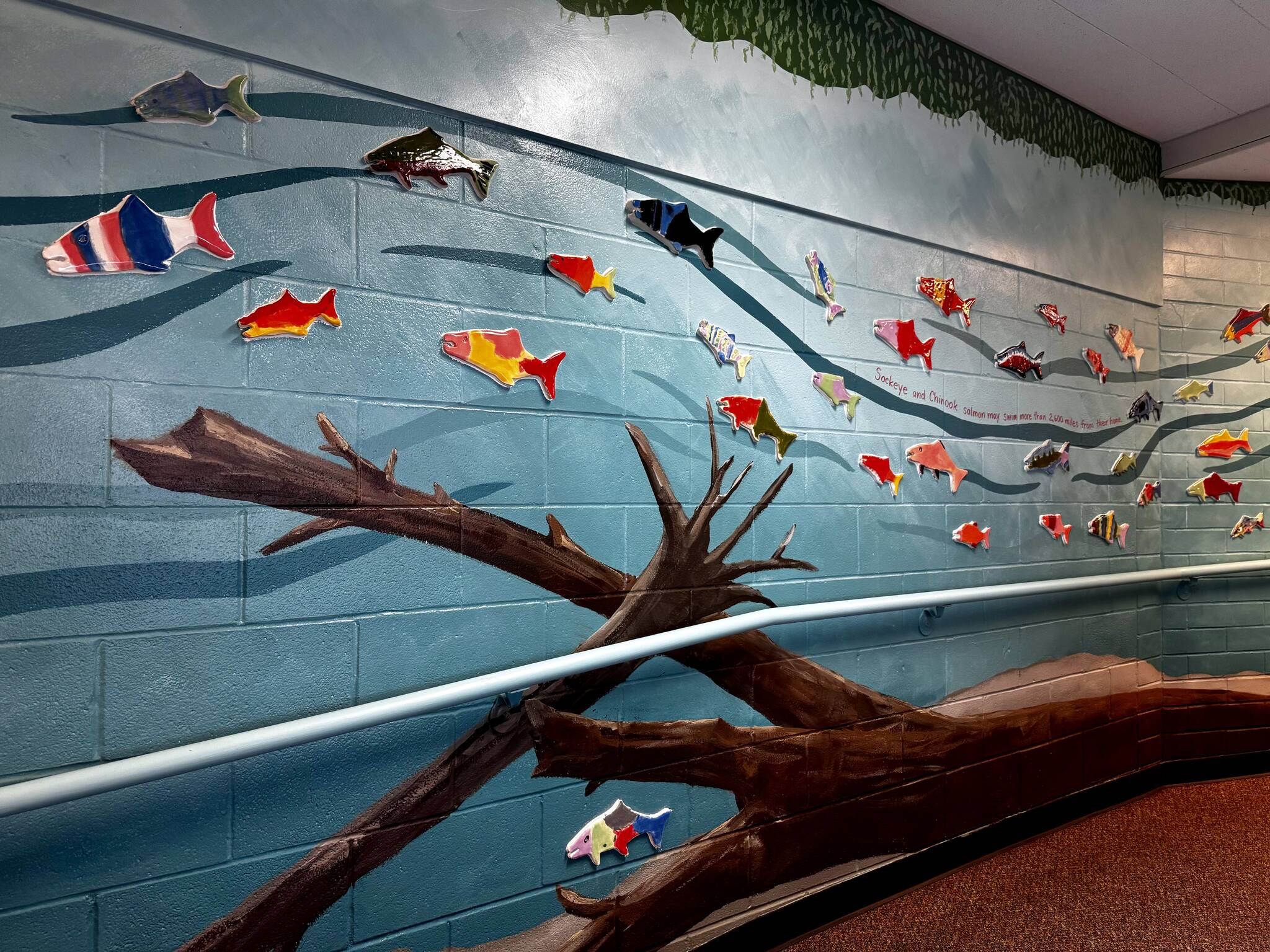Students, staff and visitors entering Carnation Elementary will now be greeted with a 100-foot run of ceramic salmon swimming through a painted Snoqualmie River.
The new mural, on the east side of the building, stretches along the outdoor corridor between the school’s front office and its multipurpose room, frequented by many people each day. The mural continues along the interior hallway of the same wall, spanning 149 feet. The project was initiated by Simone Oliver, president of Carnation’s Lee Arts Foundation, and done in collaboration with Carnation Elementary’s Parent Teacher Student Association. The PTSA hosted an unveiling of the artwork on Sept. 2, complete with a few speeches and salmon-inspired treats catered by Carnation Cafe.
This project is a long time coming for Oliver, who first had the idea about 15 years ago. Her own kids went to Carnation Elementary starting in 2004, and since, she’s been one of the school’s art docents, a group of parent volunteers who organize art projects. Her idea for the mural was turned down by a few different principals before she received a big yes from Michelle Frank, who started as principal last October.
Oliver then approached PTSA co-president Kyla Page, who was brought to tears by the idea.
“The more that we invest in the space, the more the people who work there and learn there and volunteer there feel important,” Page said. “[The school] needed to be paid attention to.”
Page said she was again brought to tears at the meaning behind Oliver’s mural. The salmon are born in the rivers, swim downstream to Puget Sound as adults, and then return upstream to the rivers once they are ready to reproduce.
“I realized later, as we were working on this, that it’s such a wonderful analogy to children as they’re growing up,” Oliver said. “They’re little and then they go out into the world and then they return back home.”
Oliver and her team titled the interior section of the mural, which shows smaller fish swimming downstream, “Time to Explore.” The exterior piece, with larger fish swimming upstream, is called “Homeward Bound.”
“Those two messages are just so deeply inspirational and personal to those of us who love Carnation and call it home and have children who we want to see leave and spread their wings,” Page said. “What more inspirational message can we give to our children than, ‘Go do. Go create. Go invest. Go make a mark out in this world. It is all there for you, go out and explore.’”
The project was funded from a few different sources. The PTSA paid for materials, putting in at least $2,000, and Frank was able to provide $2,500 from the school’s budget. Lee Arts, which takes donations, used more than $8,000 to pay the artists who worked on the project.
Hundreds of individuals gave their time to the project, including more than 400 students and staff, several professional artists and many volunteers. Oliver worked with Seattle graphic designer Chloe Fearing to develop a schematic of the mural. The core team of artists also included co-founder of LAF Jules Hughes, Carnation artist Jennifer Ressler, Carnation ceramicist Tassin Smith and Duvall artist Sarah Tharrington.
Last spring, the art docents learned how to glaze ceramics so they could facilitate glazing sessions during school. Each student glazed at least one of the ceramic salmon, and Smith fired all of them in the kiln. Hughes asked a tile expert the best way to attach the salmon to the wall — they had to be strong enough to stand up to children potentially climbing on them, Page said. They ended up using mastic, a plant resin used widely as adhesive in construction.
The team of artists, as well as some volunteers, spent an estimated 150 hours painting the mural one week in July. The ceramic salmon were installed by a different team over a couple of weeks in August, Oliver said.
In total, there are 578 salmon, varying widely in size, color and design. Some have cracks in them, the inclusion of which Page said was intentional.
“The process of painting and celebrating whatever comes out of that is a good lesson for the kids — and the adults,” she said. “Art is supposed to turn out the way that it does.”
With volunteers ages 4-70, Oliver and Page said the project is a testament to the kind of community Carnation has.
“Living here and raising children feels magical, and I think that that inspires people to show up for each other,” Page said. “People feel a greater sense of investment and pride in giving back to our community. I can’t think of a more deserving place to invest time and talent than into our schools.”


